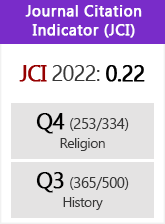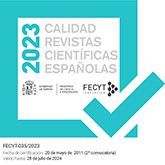Sanctioning Knowledge
DOI:
https://doi.org/10.3989/alqantara.2014.012Keywords:
History of science, Narratives about knowledge and rulers, Abbasids, Normans, Timurids, social normsAbstract
In this paper, I discuss stories about rulers and princes of three dynasties - Abbasid, Norman and Timurid – and their narrative representation as prime knowers of the mathematical sciences, geography and history. I argue that they constitute one set of positive forms of sanctioning or contesting knowledge in those societies by prescribing hierarchies of knowledge forms and hierarchies of people and institutions that decide about the veracity of knowledge. I suggest that these stories share their origin and meaning in an environment of legitimizing propaganda for the various rulers and princes. I also claim that the value and position of scientific knowledge in these stories differ, starting from what apparently were personal interests of a ruler and leading to its integration into what was considered necessary for the education of a prince and the cultured behaviour of a ruler. Hence, these stories about knowledge and rulers present images of knowledge that delineate the status of scholars in those three societies and thus define possibilities and set boundaries for learning and practicing scholarly fields.
Downloads
References
Ahmad, Sayyid Maqbul, "Cartography of al-Sharīf al-Idrīsī," in History of Cartography, Volume 2, Book 1: Cartography of Traditional Islamic and South Asian Societies, Chicago, Ill.-London, University of Chicago Press, 1992, pp. 156-174.
Ando, Shiro, "Die timuridische Historiographie II: Šaraf al-dīn 'Alī Yazdī, " Studia iranica, 24 (1995), pp. 219-246. http://dx.doi.org/10.2143/SI.24.2.2003973
Aubin, Jean, "Le Mécénat Timouride à Chiraz," Studia Islamica, 7 (1957), pp. 71-88. http://dx.doi.org/10.2307/1595248
Cooperson, Michael, Classical Arabic Biography: the Heirs of the Prophets in the Age of al-Ma'mūn, Cambridge, Cambridge University Press, 2000.
El-Hibri, Tayeb, Reinterpreting Islamic Historiography, Cambridge, Cambridge University Press, 1999, Cambridge Studies in Islamic Civilization.
Fairclough, Norman, Critical Discourse Analysis: Papers in the Critical Study of Language, Harlow, Longman Group Limited, 1995.
Forbes Manz, Beatrice, "Tamerlane and the Symbolism of Sovereignty," Iranian Studies, 21 (1988), pp. 105-122. http://dx.doi.org/10.1080/00210868808701711
Gutas, Dimitri, Greek Thought, Arabic Culture: The Graeco-Arabic Translation Movement in Baghdad and Early 'Abbasid Society (2nd–4th/8th–10th centuries), London-New York, Routledge, 1998.
Houben, Hubert, Roger II of Sicily: A Ruler between East and West, Cambridge, Cambridge University Press, 2002.
King, David A., "Too Many Cooks... A New Account of the Earliest Muslim Geodetic Measurements," Suhayl, 1 (2000), pp. 207-242.
Langermann, Tzvi, "The Book of Bodies and Distances of Ḥabash al-Ḥāsib," Centaurus, 28 (1985), pp. 108-228. http://dx.doi.org/10.1111/j.1600-0498.1985.tb00831.x
Lentz, Thomas W. and Lowry, Glenn D. (eds.), Timur and the Princely Vision, Persian Art and Culture in the Fifteenth Century, Washington D.C., Smithsonian Institution Press, 2007.
Matvievskaya, G.P. and Rozenfel'd, B.A., Matematiki i astronomy musul'manskogo srednevekov'ja i ich trudy (VIII-XVII vv.), Moscow, Nauka, 1983, 3 vols.
Melvin-Koushki, Matthew S., The Quest for a Universal Science: The Occult Philosophy of Ṣā'in al-Dīn Turka Iṣfahānī (1369-1432) and Intellectual Millenarianism in Early Timurid Iran, Ph D Thesis, New Haven, Yale University, 2012.
Mercier, Raymond, "Geodesy," in History of Cartography, Volume 2, Book 1: Cartography of Traditional Islamic and South Asian Societies, Chicago, Ill.- London, University of Chicago Press, 1992, pp. 175-188.
Quinn, Sholeh A., "The Timurid Historiographical Legacy: A Comparative Study of Persianate Historical Writing," in Andrew J. Newman (ed.), Society and Culture in the Early Modern Middle East: Studies on Iran in the Safavid Period, Leiden, Brill, 2003, pp. 19-32.
Roxburgh, David. J., The Persian Album 1400-1600: From Dispersal to Collection, New Haven, Yale University, 2005.
Soucek, Priscilla P., "The Manuscripts of Iskandar Sultan," in Lisa Golombek and Maria Subtelny (eds.), Timurid Art and Culture. Iran and Central Asia in the Fifteenth Century. Leiden-New York-Köln, Brill, 1992, pp. 116-131.
Szuppe, Maria, "Historiography v. Timurid Period," in Encyclopaedia Iranica, 2003. http://www.iranica.com/articles/historiography-v (accessed 7 July 2011).
Thackston, Wheeler M., A Century of Princes. Sources on Timurid History and Art, Cambridge, Massachusetts, The Aga Khan Program for Islamicate Architecture, 1989.
Woods, John, "The Rise of Timurid Historiography," Journal of Near Eastern Studies, 46 (1987), pp. 81-107. http://dx.doi.org/10.1086/373225
Downloads
Published
How to Cite
Issue
Section
License
Copyright (c) 2014 Consejo Superior de Investigaciones Científicas (CSIC)

This work is licensed under a Creative Commons Attribution 4.0 International License.
© CSIC. Manuscripts published in both the printed and online versions of this Journal are the property of Consejo Superior de Investigaciones Científicas, and quoting this source is a requirement for any partial or full reproduction.All contents of this electronic edition, except where otherwise noted, are distributed under a “Creative Commons Attribution 4.0 International” (CC BY 4.0) License. You may read here the basic information and the legal text of the license. The indication of the CC BY 4.0 License must be expressly stated in this way when necessary.
Self-archiving in repositories, personal webpages or similar, of any version other than the published by the Editor, is not allowed.














